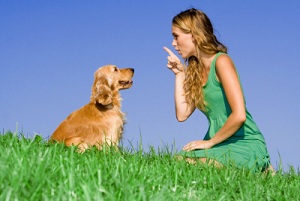- Home
- About Us
- Contact Us
- Privacy Policy
- What's New!
Dog Obedience Training
Doesn't Have To Be Stressful

You should begin dog obedience training as soon as you bring your dog home.
Even though you can’t expect too much from a very young puppy, it’s still a good idea to begin training him right away.
You should find the following dog training tips should helpful.
The Basics of Dog Obedience Training
I always recommend a POSITIVE approach to training your dog. In this approach you primarily focus on praising your dog when you he does what you want him to. Believe it or not, your dog craves your approval. Nothing makes your dog happier than get a positive response from you.
In this approach to dog obedience training, we use this fact to condition your dog to behavior properly.
A NEGATIVE approach to training involves scolding your dog whenever he makes a mistake. This is almost never successful and only serves to alienate your dog from you. If you employ this approach, your dog will not enjoy spending time with you. It will also take much longer to train your dog.
Rewards and Corrections
Using the POSITIVE approach to dog obedience training, you need to understand how to properly reward your dog when he obeys your commands. You also need to understand how to correct your dog when he makes mistakes.
Note that I said "correct your dog" and NOT punish him. You should NEVER punish your dog. It’s both ineffective and cruel because your dog doesn't have the intelligence to understand why you’re doing it.
Rewards
The best way to reward your dog is with verbal PRAISE. When your dog does something that you asked him to do, say something like “Gooooood Boy” in a slightly higher pitch than your normal voice. It's actually the tone of your voice more than the words used that does the trick.
When you do this properly, you’ll notice a change in your dog’s demeanor. His ears may go back, his tail may wag, it may almost look like he’s smiling. This is the gold! You need to see this kind of positive response from your dog.
Corrections
The best way to correct your dog is also verbally. When your dog does something he shouldn’t, you must IMMEDIATELY say (in a stern tone) “No!”
It is vital that you correct your dog immediately...preferably while he’s still doing the wrong thing. At the very least within a few seconds. If you don’t catch him in the act, don’t bother trying to correct him. Dogs have a very short memory and you’ll only end up confusing him.
Some new dog owners resist saying “No” to their dog. Instead they say something like “Now Fido that’s not being a good boy.” They do this at their own peril. Their dog will never understand that what he did was bad.
Now there are times when just saying “No” will not be sufficient to stop your dog's destructive behavior. Your dog may be so intent on what he’s doing, that he just doesn't hear you.
He’s not intentionally ignoring you, he’s just preoccupied with what he’s doing. In these cases, use the following techniques:
- Do something that will STARTLE your dog but will not hurt him. You might want to keep a loaded water pistol handy. A few squirts will often do the trick.You could try throwing a crinkled piece of paper at him. Or, you could toss your car keys on the floor beside him. Anything that will get his attention will usually work.
- If your dog still fails to stop the destructive activity, then you’ll need to get a little physical with him. Try shaking him by the scruff (back of the neck) while shouting “No!” A quick pinch of the earlobe can also be effective. Both techniques will remind your dog of how his mother corrected him.
For proper dog obedience training, always correct your dog by using your head and not your emotions. Never give a correction to your dog by losing your temper and screaming at him. Your correction should never make your dog cower in fear.
IT SHOULD ONLY MAKE HIM STOP WHAT HE’S CURRENTLY DOING.
Important Factors in Dog Obedience Training
Persistence and consistency are 2 of the most important factors if you’re going to be successful in training your dog.
Consistency
You must first be consistent in your training. Imagine trying to teach your dog to sit. If one time you used the command SIT and the next time you said DOWN (which is actually the command for “lay down”), your dog would get very confused. And, who wouldn't.
Be consistent in what you expect your dog to do. If you expect your dog to stay off the couch, never let him on it. Also be consistent in the commands you give him. For example, if you want your dog to sit, always say SIT.
Persistence
Dog obedience training also requires that you be very persistent. It is only through repetition that your dog will learn to do what you expect. The best practice is to set aside 2 training periods a day with each lasting about 15 minutes.
Don't overdo it. Longer training sessions can actually make training harder.
During these training sessions, you’ll repeat your training until your dog does what you want on command. Then you can move onto another command using the same process.
Remember that even outside of your planned training sessions, you must still be consistent or you will undo you training efforts.
You Are Always Training Your Dog
Before you begin training, however, you must decide what you expect from your dog. You must decide what behavior in your dog will be acceptable and what behavior you plan to forbid.
If you skip this step, you’ll find that you’re not very consistent and your dog will not be clear on what you want from him. And once you decide, you must ALWAYS be consistent.
For instance, let’s say that you decide that you don't want your dog on the furniture. If you let him on the couch when you’re watching TV, you’ll defeat your training efforts by confusing him.
Your dog is not smart enough to understand that sitting with you on the couch is okay, but otherwise the couch is off limits.
Remember that consistency is everything.
Becoming the "Alpha Dog"
If you are going to be successful in your dog obedience training, you must establish yourself as the “Alpha Dog” right from the start.
Let me explain...
Dogs are descendants of wolves and wolves are pack animals. It is in their genes to live within a very structured “family.” Your dog expects that there will be a leader in this family...an alpha dog.
If you don’t take on that role, your dog will. If that happens, you’ll find training very difficult. He won’t want to follow your direction, he’ll want you to follow him.
So how do you establish yourself as the alpha dog?
- Take charge of your dog from the beginning. Be his master and not his buddy.
- When you walk your dog, don’t let him take you wherever he wants to go. Make him go where you want to go.
- Before giving him a treat, make him do a simple trick that you’ve trained him to do. I ask my dog to SIT and then “Shake” hands before he gets any treat.
- Don’t be too quick to lavish your dog with attention. Make him perform a simple trick first...then go for it.
Some new dog owner don’t like thinking of themselves as the master. They prefer the roll of buddy. This is natural from a human perspective, but it is unnatural to dogs.
Your dog will be much happier knowing his place within the family. You’ll be much happier if your dog sees you as his master.
If you have more than one dog...
...you need to establish an order for them as well. One particular dog should always be fed first and the other second. When you come home, always greet that same one first.
Dogs thrive on order and its up to you to give it them. If you fail to do this, they will work it out for themselves...often through fighting.
And when you introduce a new dog into the family, they should always go to bottom of the pecking order. They should be fed and greeted last. There will be much more harmony in the family if you keep to this rule.
Confine Your New Dog When You Can't Supervise Him
When you begin dog obedience training, remember that it’s going to take time for your dog to understand what you expect. If you are consistent, it will happen much more quickly. But it will still take time.
Before your dog is fully trained, you should plan on confining him when you can’t supervise him. A new puppy can get into lots of trouble if you don’t confine him or watch him.
For short periods (up to a few hours), a dog crate is a good way to confine your dog. Just make sure that the crate is big enough for your dog stand up, turn around and lie down comfortably.
For longer periods, I recommend a small room with a gate. Please don’t lock him behind closed doors. This can make a dog feel very isolated.
Make sure that you prepare the room ahead of time so that there’s nothing available that your dog can chew, eat, scratch or otherwise destroy.
Examples of Dog Obedience Training
Train a Dog to Lie DOWN
Train a Dog to STAY
Train a Dog to COME
Train a Dog to HEEL






